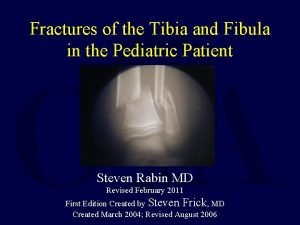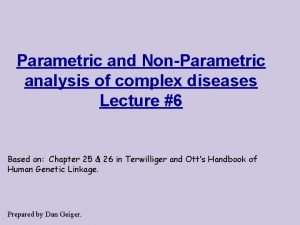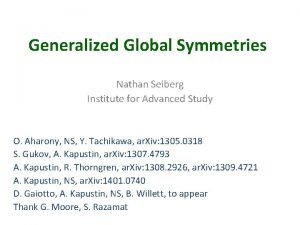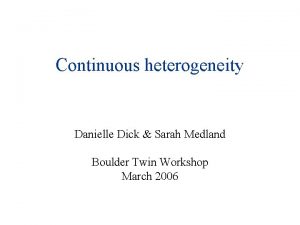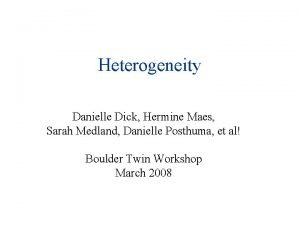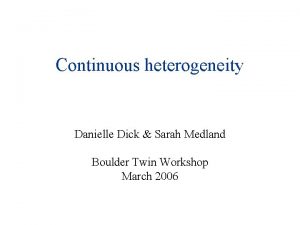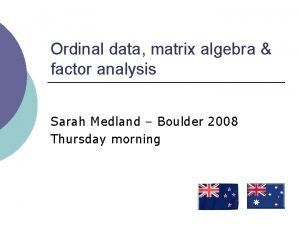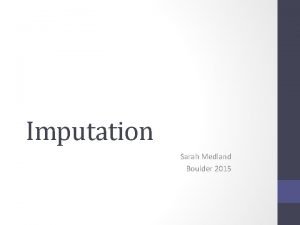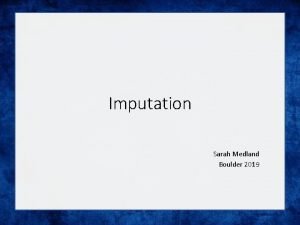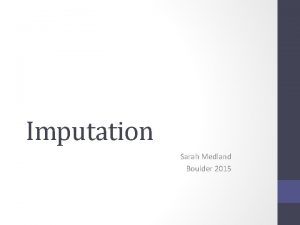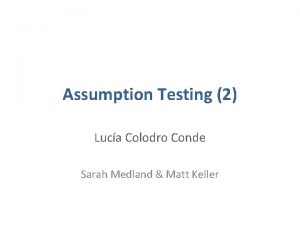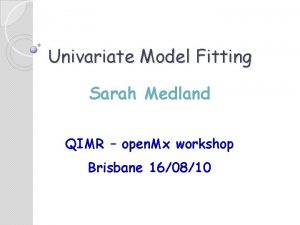Heterogeneity Sarah Medland Nathan Gillespie Types of Heterogeneity
































- Slides: 32

Heterogeneity Sarah Medland & Nathan Gillespie

Types of Heterogeneity • Terminology depends on research question – Moderation, confounding, Gx. E • Systematic differences – Measured or Manifest moderator/confounder • Discrete traits • Ordinal & Continuous traits (Thursday) – Unmeasured or latent moderator/confounder • Moderation and Gx. E

Heterogeneity Questions • Univariate Analysis: – What are the contributions of additive genetic, dominance/shared environmental and unique environmental factors to the variance? • Heterogeneity: – Are the contributions of genetic and environmental factors equal for different groups, – sex, race, ethnicity, SES, environmental exposure, etc. ?

The language of heterogeneity • Are these differences due to differences in the magnitude of the effects (quantitative)? – e. g. Is the contribution of genetic/environmental factors greater/smaller in males than in females? • Are the differences due to differences in the source/nature of the effects (qualitative)? – e. g. Are there different genetic/environmental factors influencing the trait in males and females?

The language of heterogeneity • Sex differences = Sex limitation 1948 1840 1861

The language of heterogeneity Quantitative - differences in the magnitude of the effects Models - Scalar - Non-scalar with OS twins Qualitative - differences in the source/nature of the effects Models - Non-scalar without OS twins - General Non-scalar

The language of heterogeneity • Scalar limitation (Quantitative) – % of variance due to A, C, E are the same between groups – The total variance is not ie: • • var. Female = k*var. Male AFemale = k*AMale CFemale = k*CMale EFemale = k*EMale k here is the scalar

1 1/. 5 1 E e C 1 c 1 A a C 1 a Twin 1 c Twin 2 No Heterogeneity E 1 e

1 1/. 5 1 E 1 C e c 1 a Twin 1 MZ a 2+c 2+e 2 a 2+c 2 A 1 C 1 E a c e Twin 2 a 2+c 2+e 2 DZ a 2+c 2+e 2. 5 a 2+c 2+e 2

1 1/. 5 1 E e C 1 c Male Twin 1 a A 1 A C 1 1 E k*a k*c k*e Female Twin Scalar Sex-limitation aka scalar sex-limitation of the variance

The language of heterogeneity • Non-Scalar limitation – Without opposite sex twin pairs (Qualitative) • var. Female ≠ var. Male • AFemale ≠ AMale • CFemale ≠ CMale • EFemale ≠ EMale

The language of heterogeneity • Non-Scalar limitation – Without opposite sex twin pairs (Qualitative) • Male Parameters – means. M – AM CM and EM • Female Parameters – mean. F – AF CF and EF Parameters are estimated separately

Male ACE model 1 1/. 5 1 E M CM 1 1 AM e. M c. M a. M Twin 1 1 AM 1 CM 1 EM a. M c. M e. M Twin 2 1 1/. 5 1 EF 1 CF 1 AF e. F c. F a. F Female ACE model Twin 1 1 AF 1 CF 1 EF a. F c. F e. F Twin 2

The language of heterogeneity • Non-Scalar limitation – With opposite sex twin pairs (Quantitative) • Male Parameters – means. M – AM CM and EM • Female Parameters – mean. F – AF CF and EF Parameters are estimated jointly – linked via the opposite sex correlations r(AFemale , Amale) =. 5 r(CFemale ≠ CMale ) = 1 r(EFemale ≠ EMale ) = 0

1. 5/1 1 EM 1 CM e. M c. M Male Twin 1 a. M AM 1 AF CF 1 a. F 1 c. F Female Twin Non-scalar Sex-limitation aka common-effects sex limitation EF e. F

The language of heterogeneity • General Non-Scalar limitation – With opposite sex twin pairs (semi-Qualitative) • Male Parameters – means. M – AM CM EM and ASpecific – Extra genetic/ environmental effects • Female Parameters – mean. F – AF CF and EF Parameters are estimated jointly – linked via the opposite sex correlations

1. 5/1 EM 1 AS 1 1 CM e. M c. M 1 a. M AM 1 AF CF 1 a. F 1 c. F as Male Twin Female Twin General Non-scalar Sex-limitation aka general sex limitation EF e. F

The language of heterogeneity • General Non-Scalar limitation via r. G – With opposite sex twin pairs (semi-Qualitative) • Male Parameters – means. M – A M C M EM • Female Parameters – mean. F – AF CF and EF Parameters are estimated jointly – linked via the opposite sex correlations r(AFemale , Amale) = ? (estimated) r(CFemale ≠ CMale ) = 1 r(EFemale ≠ EMale ) = 0

1 ? 1 EM 1 CM e. M c. M Male Twin 1 a. M AM 1 AF CF 1 a. F 1 c. F Female Twin General Non-scalar Sex-limitation aka general sex limitation EF e. F

How important is sex-limitation? • Let have a look – Height data example using older twins – Zygosity coding • 6 & 8 are MZF & DZF • 7 & 9 are MZM & DZM • 10 is DZ FM – Scripts ACEf. R ACEm. R ACE. R – Left side of the room ACEm. R – Right side of the room ACE. R – Record the answers from the est. ACE* function

How important is sex-limitation? • Female parameters • Male parameters • Combined parameters • Conclusions?

Lets try this model 1 ? 1 EM 1 CM e. M c. M Male Twin 1 a. M AM 1 AF CF 1 a. F 1 c. F Female Twin General Non-scalar Sex-limitation aka general sex limitation EF e. F

twin. Het 5 Ace. Con. R • Use data from all zygosity groups

1 ? 1 EM 1 CM 1 e. M c. M a. M Male Twin AM 1 AF 1 CF 1 EF a. F c. F e. F Female Twin

1 ? 1 EM 1 CM 1 e. M c. M a. M Male Twin AM 1 AF 1 CF 1 EF a. F c. F e. F Female Twin

Means • Have a think about this as we go through – is the best way to set this up?

Covariances


Run it • What would we conclude? • Do we believe it? • Checking the alternate parameterisation…

Lets try this model 1 ? 1 EM 1 CM e. M c. M Male Twin 1 a. M AM 1 AF CF 1 a. F 1 c. F Female Twin General Non-scalar Sex-limitation aka general sex limitation EF e. F


Means • Add a correction using a regression model • expected. Mean = male. Mean + β*sex β is the female deviation from the male mean Sex is coded 0/1
 Sarah medland
Sarah medland Brett gillespie
Brett gillespie Lori gillespie
Lori gillespie Ann gillespie ira
Ann gillespie ira Chuck gillespie
Chuck gillespie Site:slidetodoc.com
Site:slidetodoc.com Vickie gillespie
Vickie gillespie Duncan gillespie pilot
Duncan gillespie pilot Allelic heterogeneity
Allelic heterogeneity Heterogeneity in distributed systems
Heterogeneity in distributed systems Allelic heterogeneity
Allelic heterogeneity Allelic heterogeneity
Allelic heterogeneity Out group homogeneity
Out group homogeneity Savana
Savana All customers differ
All customers differ 324marketing
324marketing Nathan dickinson
Nathan dickinson Nathan barrios
Nathan barrios Nathan seiberg
Nathan seiberg Nathan brunelle
Nathan brunelle Brian middendorf
Brian middendorf Marybeth tinning heute
Marybeth tinning heute Nathan dalrymple
Nathan dalrymple Nathan liskov
Nathan liskov Nathan rinne
Nathan rinne Nathan dalrymple
Nathan dalrymple Nathan seiberg
Nathan seiberg Ackerman family therapy
Ackerman family therapy Minnieamy
Minnieamy Nathan weiss graduate college
Nathan weiss graduate college Glenn nathan
Glenn nathan Nathan boylan
Nathan boylan Nathan younge
Nathan younge





